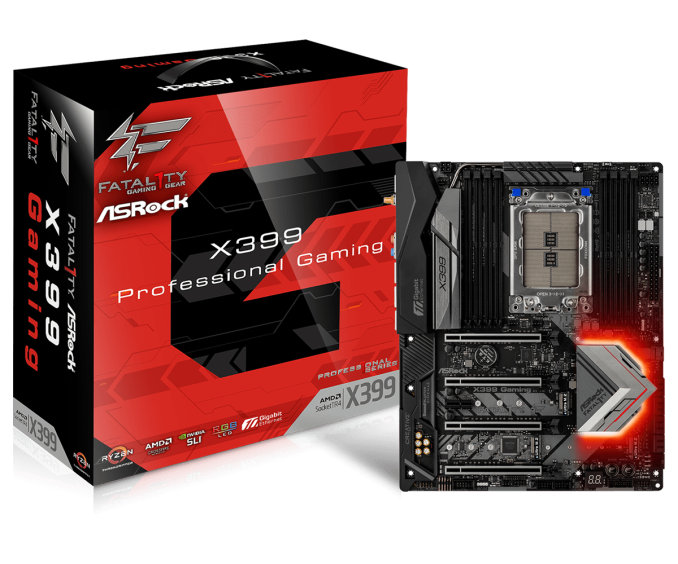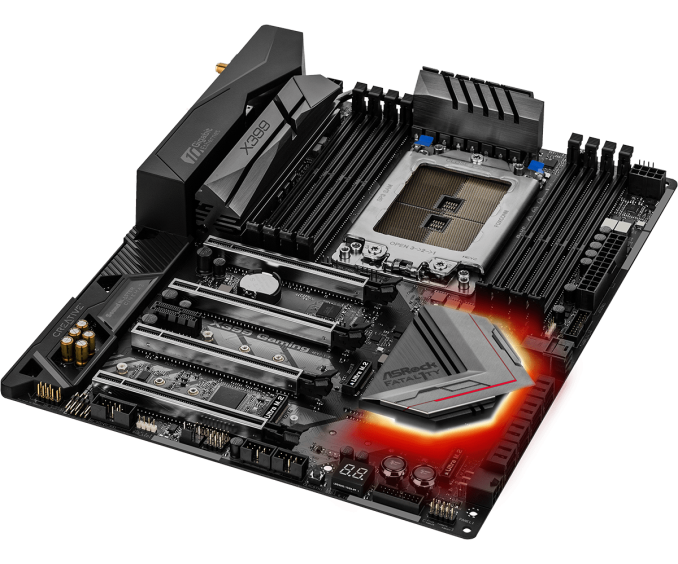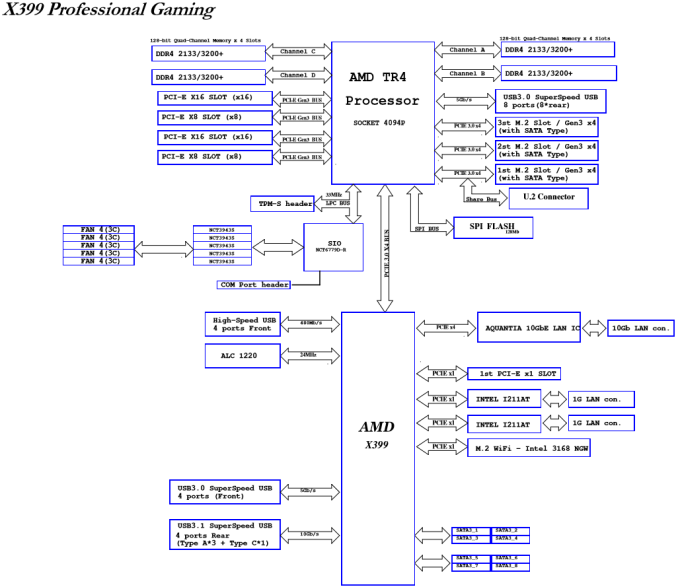An AMD Threadripper X399 Motherboard Overview: A Quick Look at Seven Products
by Ian Cutress & Joe Shields on September 15, 2017 9:00 AM ESTASRock
No stranger to the fray, ASRock is ready with the launch of two boards, the X399 Professional Gaming and X399 Taichi. Both boards share features but have enough differences to separate them in the product stack. The Pro Gaming adds 10 Gigabit Ethernet to its two Gigabit NICs and supports Creative Sound Blaster Cinema 3, while the Taichi aims to be a more mid-range board, by sticking with dual Gigabit NICs and uses Purity Sound 4. The styling is a little different too.
ASRock X399 Professional Gaming
The high-end board from ASRock will be the Professional Gaming. It also carries the Fatal1ty name, due to ASRock’s never-ending association with a pro-gamer from the turn of the century.
On the aesthetic side, the X399 Professional Gaming has a black PCB accented with gray heatsinks and grey stenciling where the M.2 slots are located. The memory slots are black, along with the rear IO cover that extends down the board. There are two heatsinks to cool the VRMs, connected by a heatpipe, and one reaches near to the rear IO. The chipset heatsink is not connected as part of the VRM cooling, but consumes a fairly large portion of the board and looks a bit like a play button. As with the fascination with RGB, the Professional Gaming has a few under the chipset heatsink. Users can add more RGB LEDs via two headers, and control them all through ASRock's RGB LED application.
The Professional Gaming has support for both NVIDIA 4-Way SLI and AMD 4-Way Crossfire with full-length PCIe slots. These have additional reinforcement to prevent sag or bending due to heavy PCIe cards during transit – the reinforcement is what ASRock calls its ‘Steel Armor’. The PCIe slots give an x16/x8/x16/x8 configuration from top to bottom, using 48 of the 60 PCIe lanes from the processor. The rest of the lanes are allocated to storage: there are a total of three M.2 PCIe 3.0 x4 slots, one of which is shared/switched with a U.2 connector. For other storage, there are eight SATA ports from the chipset that natively support RAID 0/1/10.
For added features, the X399 Professional Gaming jumps past the ever-present Gigabit Ethernet and uses an Aquantia AQC107 10 Gigabit LAN controller to appeal to users that want to invest in 10GbE. This is paired with two Intel I211AT network controllers, and all three can do regular gigabit Ethernet duties. If three Ethernet ports were not enough, also included is an integrated Intel AC8265 2x2 802.11a/b/g/n/ac WiFi module, to handle wireless duties.
ASRock provided chipset diagram for the Pro Gaming to show how it breaks down all the bandwidth:
For power delivery, ASRock uses a digital 11 phase International Rectifier solution, along with IR DrMOS for monitoring VRM current and temperature. Distributing power to the VRMs are two EPS 12V connectors, an 8-pin and a 4-pin, although the system will work with only the 8-pin installed. Typically we see EPS connectors oriented close to each other at the top of the motherboard, but here the connectors are located on opposite sides of the socket. As shown above, the 8-pin is in the upper right-hand corner above the DIMM slots, while the supplemental 4-pin is in the more familiar location at the top left-hand corner. ASRock asserts this creates a wider trace for the CPU VRM, bringing better power delivery efficiency and lowering temperatures.
For USB connectivity, the Professional Gaming has three USB 3.1 (10 Gbps) Type-A ports on the rear, one USB 3.1 (10 Gbps) Type-C port on the rear, two USB 3.1 (5 Gbps) headers for front panel ports, and two USB 2.0 headers for front panel ports.
| Fatal1ty X399 Professional Gaming | |
| Warranty Period | 3 Years |
| Product Page | Link |
| Price | $439.99 |
| Size | ATX |
| CPU Interface | TR4 |
| Chipset | AMD X399 |
| Memory Slots (DDR4) | Eight DDR4 Slots, up to 3600 MT/s Supporting 128GB Quad Channel |
| Network Connectivity | 1 x Aquantia AQC107 10 Gigabit LAN 2 x Intel I211AT GbE |
| Wireless Network | 802.11 ab/g/n/ac Dual-Band (2.4/5 GHz) Bluetooth 4.2 |
| Onboard Audio | Realtek ALC1220 |
| PCIe Slots | 4 x PCIe 3.0 (x16/x8/x16/x8) from CPU 2 x PCIe 2.0 x1 from Chipset |
| Onboard SATA | 8 x SATA 6 Gbps Supporting RAID 0/1/5/10 |
| Onboard SATA Express | None |
| Onboard M.2 | 3 x PCIe 3.0 x4 - NVMe or SATA |
| Onboard U.2 | 1 x PCIe 3.0 x4 (disables M2_1 when in use) |
| USB 3.1 | 1 x Type-A , 1 x Type-C (Rear Panel) |
| USB 3.0 | 8 x Rear Panel, 4 x via internal headers |
| USB 2.0 | 4 x via internal headers |
| Power Connectors | 1 x 24-pin ATX 1 x 8-pin CPU 1 x 4-pin CPU |
| Fan Headers | 1 x CPU 1A/12W Max. (4-pin) 1 x CPU Opt/Water Pump 1.5A/18W Max. (4-pin) 2 x Chassis (4-pin) 1 x Chassis Opt/Water Pump 1.(4-pin) |
| IO Panel | 2 x Antenna Ports 1 x PS/2 Mouse/Keyboard Port 1 x Optical SPDIF Out Port 1 x USB 3.1 Type-A Port (10 Gb/s) 1 x USB 3.1 Type-C Port (10 Gb/s) 8 x USB 3.0 Ports 4 x USB 3.0 Ports 3 x RJ-45 LAN Ports w/ LED 1 x BIOS Flashback Switch HD Audio Jacks |
















99 Comments
View All Comments
ddriver - Monday, September 18, 2017 - link
You should look up into it. A gas turbine is not a jet engine. It is actually more efficient, and it doesn't utilize jet propulsion. Gas turbines power certain tanks, ships and helicopters. They are also used in power plants.thomasg - Sunday, September 17, 2017 - link
Honestly, could you just stop bringing your stupid gas turbine rant, since you don't really seem to grasp what efficiency is, and not even what power a typical engine has.Gas turbines are very efficient in use at or around their designed typical load. They are not efficient under medium and low load scenarios, where they will drop below modern gasoline combustion engines.
Those come with 200 kW - in high-powered sports cars, or top-of-the-line luxury limousines.
A "entry level car" will be at max. 75 kW peak power; and guess what: most of the time they are used far below the maximum output.
Modern gasoline car engines typically reach 45% efficiency, which they achieve in their typical load scenarios, at less than 50% of their design load.
Modern gas turbines can reach up to 60% efficiency, which is great - but this is usage at their design load. At half load, the efficiency will drop below 30%. The majority of miles driven with cars are at below half load.
What we expect from car engines is efficiency at their usage, while having enough reserves for quick acceleration. Gas turbines cannot do this efficiently, and gas turbines are notoriously laggy in variable load.
However, they can be used effectively in fully-hybrid cars, where peak-load is achieved by battery-backed electric motors.
But since these engines are so expensive to produce, it is simply more cost-effective to use fully-electric cars for this.
ddriver - Monday, September 18, 2017 - link
Of course that a gas turbine consumer vehicle will also utilize a battery buffer. You basically charge it while stationary, drive on battery until power runs out, which is when the turbine is activated to supply power and charge. An all-electric drive will significantly simplify the design, the transmission, and will ensure maximum torque on any level of power.You are way off, only F1 engines approach 50% of efficiency, but they only last like a few races, which is the cost of that efficiency. Totally impractical for consumer vehicles. The typical operational efficiency of consumer vehicles is as low as 20%. And they are also intrinsically limited in terms of torque delivery, which happens in a specific and rather narrow RPM range.
So, transitioning to gas turbine engines will not have a 100% but a 200% increase in efficiency. I guess little minds simply cannot appreciate then significance of that. Not to mention it will defacto force wide hybrid vehicle adoption, and a very overhead compared to internal combustion engines, as a gas turbine with the same power delivery will weight 1/4 of that, and will deliver 3 times as much energy from the same amount of fuel.
Gas turbine engines are also actually easier to make and maintain, they have far less moving parts. You seem to be confusing a regular gas turbine engine with the ultra-efficient one, which requires expenssive and time staking 5 axis machining of the components. Those exceed 70% efficiency, but if you aim for 60%, the manufacturing is much cheaper, easier and faster. Overall much more cost efficient.
Which is exactly why they are not being adopted. It will result in massive loss of revenue - cheaper engines, that need less of the expensive maintenance, less parts, and burn much less fuel. The priority of the industry is profit, and gas turbine vehicles will result in a massive dip in that aspect. Internal combustion engines are pathetic in terms of efficiency, but are very profit-effective.
ddriver - Monday, September 18, 2017 - link
"and a very LOW overhead compared to internal combustion engines"vgray35@hotmail.com - Sunday, September 17, 2017 - link
Get a glue ddriver. This is not about power saved whose numbers are minuscule compared to the power o/p of an automobile engine - IT IS ALL ABOUT TEMPERATURE OF THE INTEGRATED CHIPS WHICH ARE LIMITED TO NOT MUCH MORE THAN 100 deg C, and the difficulty of providing sufficient air flow or liquid cooling necessary to remove that heat. Failure to remove the heat dramatically reduces life of the chips by as much as 60% - 70% life reduction. The problem is greatly curtailed by not using circuity designs that would generate ever larger amounts of waste heat. Please stick to subject matter of this posting, which is about reducing CPU and GPU and VRM operating temperatures, without using huge heat sinks and liquid cooling radiators. How does one reduce these temperatures? The first step is to eliminate >85% of the heat in the ATX PSU, motherboard VRMs, and GPU VRMs, to reduce total heat load on the cooling system. And that technology is already available as mentioned above. Please cease with the 100 kW rhetoric which is meaningless in context of this temperature problem (yes little k for kilo not capitol K). Let's talk about the excess temperature issue. Get it!Thread Ripper is a HEDT platform and thus deserves a HEDT VRM solution, and not the same old worn out technologies that use air-gapped ferrite cored inductors, when resonance scaling permits increased resonant capacitance in exchange for much smaller resonant inductance using cheaper air-cored inductors. And to boot, a dramatic reduction is both size and cost. AMD should lead this charge and bring forth an appropriate reference VRM, using PWM-resonant switching and resonance scaling of the Cr/Lr resonant components. ARE YOU LISTENING AMD - LETS RETIRE THE BUCK CONVERTER ACROSS THE BOARD.
ddriver - Monday, September 18, 2017 - link
Getting glue. Now what?Here is a clue - remove the stock heatsink, install better cooling. Takes like 5 minutes. Heat problem solved. Crude, but it delivers result.
The industry standards are so low, there is barely a product, regardless of its price range, that someone with basic engineering cannot tangibly improve in a few easy steps.
An example, I recently got a yoga 720 2in1. Opened it up, removed the cooling, put good TIM, reinstalled cooling, now I have a 5 minute 5$ improvement that gave me a 10% boost in performance, temperature and battery life. They are just lazy, and don't go even for the most obvious, easiest to implement improvements.
They DONT WANT IT TO RUN COOL. They deliberately engineer it to run at its limit, so close that often they actually mess it up. So that this device can fail, so you can get a new one. It is a time bomb, planned obsolescence, and you can bet your ass they would have done the same regardless of the power delivery circuit involved. It may actually be a far more delicate and harder to address time bomb than hot running VRMs. Which you can easily cool down by ordering a custom heatpipe solution, which will set you back like 50$. That's a rather quick and affordable way to solve your problem, compared to complaining about it in this cesspool of mediocrity ;)
vgray35@hotmail.com - Monday, September 18, 2017 - link
Sorry ddriver, but I disagree with all your perspectives on this matter. You are clearly not capable of addressing the technical issues of Power Supply design for efficiency, and cannot get to grips with electronic circuity (or do not want to) and how different designs compare. You appear only interested in hijacking the original subject matter for your own purposes. You never contributed a single element addressing the original purpose of this thread, and so you have lost your credibility as a serious participant in my book, and hence you and I done.glennst43 - Friday, September 15, 2017 - link
Based on my experience with the Asus Zenith Extreme, you can expect a bumpy ride which should not be surprising with a new product. My last 3 systems were Intel X58, X79, and X99 boards purchased shortly after thier releases, and this platform (x399) has had the most issues. I expect that in a few months after some BIOS and driver updates, the experiecne will get much better. I suspect that the validation process is not as thorough as the Intel boards.Here are a few issues that I have experienced as an early adopter:
System would not boot with 2 video cards (resolved with BIOS update)
The 10G Network card would randomly disconnect (resolved? with driver update)
System sometimes will not come back from sleep and requires a hard reset (no resolution yet)
USB devices disconnecting/reconnecting randomly (no resolution yet)
johnnycanadian - Friday, September 15, 2017 - link
I'm crossing my fingers I made the correct choice with MSI's x399 offering. I too have been burned by the ASUS early-adopter-penalty and although Gigabyte has been good to me in the past, the MSI offered everything I needed and then some (although I'm firmly in the "get rid of the tacky LED" camp). Everything is getting stuffed into a Cooler Master HAF XB II EVO (with no glass but with the mesh top panel). Even if it's not perfect it can't be worse than running Windows on Boot Camp with a "trash can" (aptly named) Mac "Pro".arter97 - Friday, September 15, 2017 - link
ASUS PRIME X399-A : "In the ROG board this lead to a 40mm fan, which is not present here on the Prime."This is wrong. I own one and the fan is present under the shroud.
You can even see it from the side shot of the motherboard.